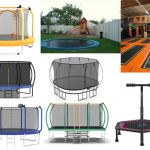- 1-Understanding-Trampoline-Use-in-Cold-Weather
- 2-How-Cold-Affects-Trampoline-Materials-and-Safety
- 3-Signs-Its-Too-Cold-to-Use-Your-Outdoor-Trampoline
- 4-Best-Practices-for-Using-a-Trampoline-in-Cold-Weather
- 5-Maintenance-Tips-for-Outdoor-Trampolines-During-Winter
- 6-Real-Life-Experience-and-Why-Cold-Weather-Matters
1. Understanding Trampoline Use in Cold Weather
Many trampoline enthusiasts wonder, when is it too cold to use a trampoline outdoors? While trampolines are durable and designed for year-round fun, cold weather introduces unique challenges that can impact both user safety and the trampoline’s lifespan. Temperatures below freezing require careful consideration before bouncing to avoid accidents or damage.
Cold weather can make trampoline surfaces stiff and less flexible, affecting bounce quality. Additionally, icy or wet conditions increase the risk of slipping, which makes safety precautions vital for outdoor trampoline use during winter months.
2. How Cold Affects Trampoline Materials and Safety
The materials used in trampoline mats, springs, and frames react to cold differently. For instance, the polypropylene used in mats can become brittle in freezing temperatures, raising the likelihood of tears or cracks. Metal springs and frames may contract or become rigid, which could compromise structural integrity.
Safety-wise, cold weather reduces flexibility, increasing injury risk during jumps. Users must be aware of these material sensitivities to ensure a safe trampoline experience.
3. Signs It’s Too Cold to Use Your Outdoor Trampoline
One clear sign that it might be too cold to use your trampoline is when the surface feels hard or brittle to the touch. Visible frost, ice patches, or snow accumulation also signal unsafe conditions. If the trampoline sounds unusually stiff or springs seem less responsive, it’s best to avoid use until temperatures rise.
Listening to your trampoline’s behavior and monitoring local weather conditions help you decide the best time for safe use.
4. Best Practices for Using a Trampoline in Cold Weather
When temperatures are cold but safe for trampoline use, follow key guidelines: wear appropriate footwear to prevent slipping, avoid jumping when the surface is wet or icy, and warm up your muscles properly before starting. Limiting bounce height and intensity can reduce injury risks related to stiffened trampoline materials.
Supervising children closely and educating all users about cold-weather risks ensures fun and safe trampoline sessions during chilly days.
5. Maintenance Tips for Outdoor Trampolines During Winter
Proper maintenance during cold months extends your trampoline’s life. Remove snow promptly, check springs and mats regularly for signs of wear, and cover the trampoline with weather-resistant tarps when not in use. Lubricating metal parts and storing detachable accessories indoors can prevent corrosion and damage.
Following a seasonal maintenance routine protects your trampoline investment through the winter and prepares it for safe use in warmer weather.
6. Real-Life Experience and Why Cold Weather Matters
Consider the story of a family in Minnesota who tried bouncing on their trampoline during a freezing snap. They noticed the mat was unusually hard and the springs noisy. Shortly after, a small tear appeared, and one child slipped due to frost. This experience underscored the importance of respecting cold weather limits and taking preventive measures.
These real-life lessons remind trampoline users to monitor weather conditions carefully and prioritize safety, ensuring the trampoline remains a source of joy rather than injury during winter months.
For expert advice and quality trampolines built to withstand diverse climates, visit Trampoline Zone, where you can find tailored recommendations and support for your outdoor trampoline needs.







 FUN N` JUMP BOUNCE RENT INC.4.0 (8 reviews)
FUN N` JUMP BOUNCE RENT INC.4.0 (8 reviews) Surge Adventure Park4.0 (920 reviews)
Surge Adventure Park4.0 (920 reviews) KIDS PLAYS4.0 (145 reviews)
KIDS PLAYS4.0 (145 reviews) The Bounce Club4.0 (90 reviews)
The Bounce Club4.0 (90 reviews) Fondy Sports Park4.0 (607 reviews)
Fondy Sports Park4.0 (607 reviews) Browns Mills Recreation center4.0 (84 reviews)
Browns Mills Recreation center4.0 (84 reviews) Are Trampoline Parks Safe for Kids? Essential Guide for U.S. Parents
Are Trampoline Parks Safe for Kids? Essential Guide for U.S. Parents How Often Should You Replace Trampoline Springs? Tips for Proper Maintenance
How Often Should You Replace Trampoline Springs? Tips for Proper Maintenance How Much Is a Trampoline? A Detailed Guide to Trampoline Costs and Buying Tips
How Much Is a Trampoline? A Detailed Guide to Trampoline Costs and Buying Tips Bounce Techniques for Stronger Legs: Effective Exercises and Tips
Bounce Techniques for Stronger Legs: Effective Exercises and Tips Essential Music Gear for Trampoline Dance: Complete Guide
Essential Music Gear for Trampoline Dance: Complete Guide Fun STEM Experiments Using Trampolines to Spark Curiosity and Learning
Fun STEM Experiments Using Trampolines to Spark Curiosity and Learning